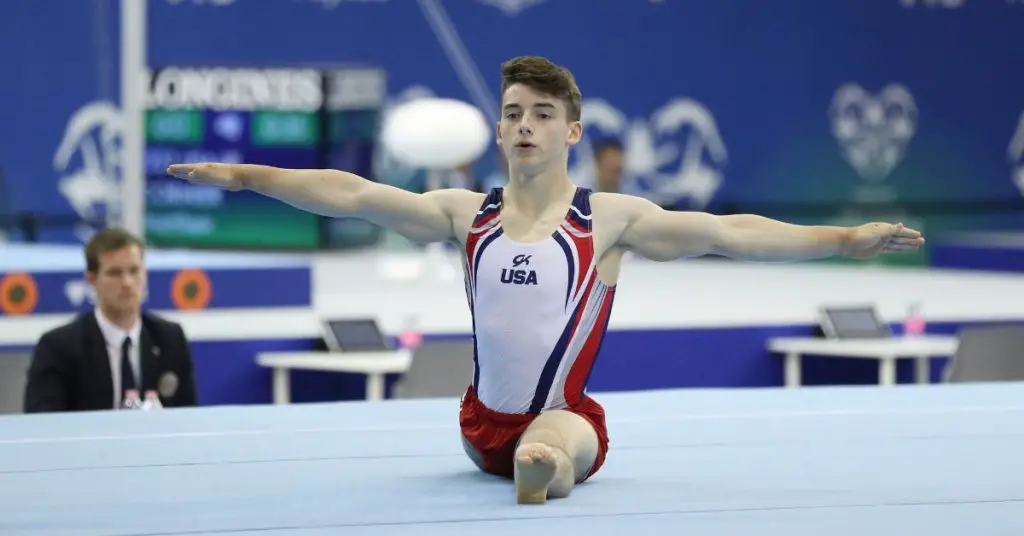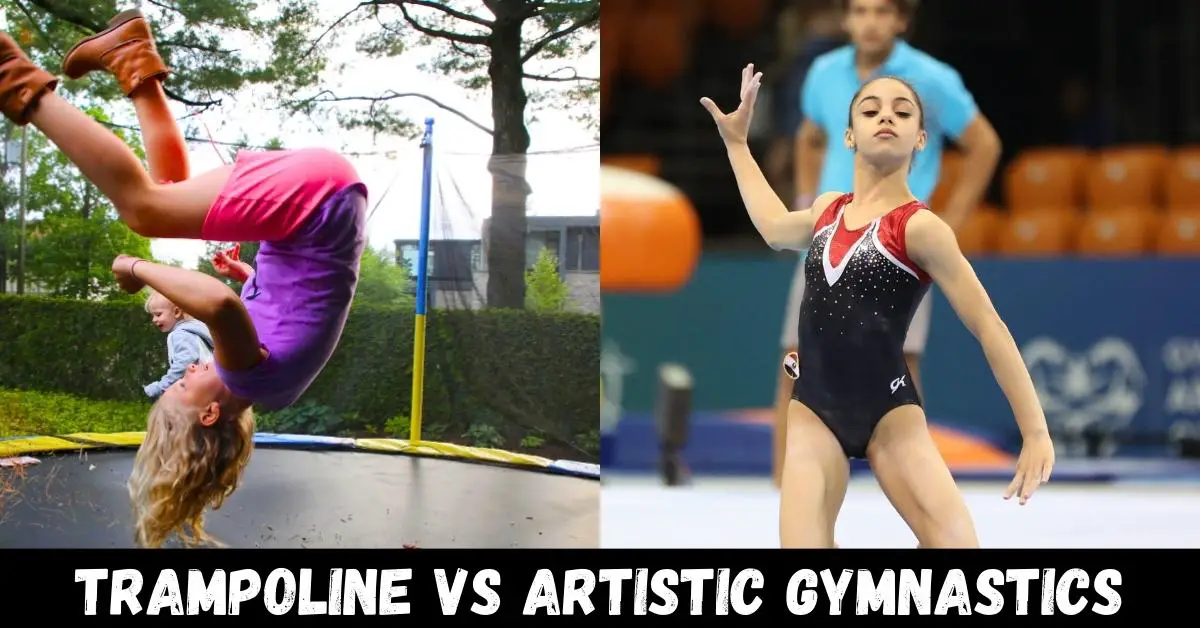Trampoline Vs Artistic Gymnastics are two distinct disciplines within the broader field of gymnastics. When gymnastics is mentioned, most people immediately think of the traditional artistic apparatus such as the floor, bars, beam, and vault.
Images of graceful routines, intricate choreography, and mesmerizing rhythmic gymnastics performances adorned with ribbons and props come to mind. It’s fascinating to note that as a trampoline gymnast myself, my initial association wouldn’t necessarily be with the word “trampoline.”
This is because trampoline gymnastics used to exist as a distinct sport, governed by the British Trampoline Association (BTA) since 1963.
However, a significant shift occurred when the BTA merged with the “British Gymnastics Association,” leading to the integration of trampolines into the unified world of gymnastics.
Trampoline Vs Artistic Gymnastics: Trampoline gymnastics and artistic gymnastics are two distinct disciplines, with trampoline offering dynamic aerial skills and artistic gymnastics showcasing grace and precision on traditional apparatus.
Trampoline

Trampoline gymnastics is a thrilling sport that combines acrobatics and aerial maneuvers on a specialized trampoline. Here’s an overview of trampoline gymnastics:
Competitive Trampoline
- Olympic and non-Olympic competitions: Trampoline gymnastics is an Olympic sport featuring both individual and synchronized events. Non-Olympic competitions like national and international championships are also held regularly.
- Scoring system and judging criteria: Trampoline routines are evaluated based on execution, difficulty, and overall performance. Judges assess factors like form, height, number of skills performed, and the complexity of the routine.
- Required skills and routines: Competitors in trampoline gymnastics are expected to master a range of skills, including basic jumps, somersaults, twists, and more advanced combinations. Routines consist of a series of connected skills performed with technical precision and creativity.
Benefits and challenges of Trampoline
- Physical benefits: Trampoline gymnastics offers numerous physical benefits, including improved cardiovascular fitness, strength, agility, and coordination. It also enhances flexibility and spatial awareness.
- Mental and emotional benefits: Trampoline gymnastics promotes mental focus, concentration, and discipline. It helps boost self-confidence as athletes overcome challenges and achieve new skills. The exhilaration of bouncing and performing aerial maneuvers can also provide a sense of joy and excitement.
- Safety considerations and challenges: While trampoline gymnastics is thrilling, safety is paramount. Athletes must be mindful of proper technique, use appropriate equipment, and receive proper training and supervision.
Like any sport, there are risks associated with trampoline gymnastics, such as the potential for falls and injuries, which should be managed and minimized through proper precautions and training.
Artistic Gymnastics
Artistic gymnastics is a captivating discipline that showcases grace, strength, and precision on various apparatus. Here’s an overview of artistic gymnastics:
Competitive Artistic Gymnastics
- Olympic and non-Olympic events: Artistic gymnastics is an Olympic sport, with competitions held at the Summer Olympic Games. There are also non-Olympic events, such as world championships, national championships, and collegiate competitions.
- Scoring system and judging criteria: Artistic gymnastics routines are evaluated based on execution, difficulty, and artistry. Judges assess elements like form, technique, difficulty of skills performed, and overall presentation to assign scores.
- Required skills and routines: Competitors in artistic gymnastics must possess various skills, including jumps, flips, twists, balances, and strength elements.
Routines are meticulously choreographed and consist of a series of connected skills performed with precision and artistry.
Benefits and Challenges of Artistic Gymnastics

- Physical benefits: Artistic gymnastics offers numerous physical benefits, including improved strength, flexibility, balance, agility, and coordination. It enhances overall fitness and body awareness.
- Mental and emotional benefits: Artistic gymnastics promotes mental focus, discipline, perseverance, and self-confidence. It instills values of hard work, goal-setting, and resilience. The artistic expression in routines also allows for creativity and self-expression.
- Safety considerations and challenges: Safety is of utmost importance in artistic gymnastics. Athletes must undergo rigorous training, adhere to proper techniques, and use appropriate safety measures.
The demanding nature of the sport presents risks of injuries, and it is crucial to prioritize safety through proper coaching, equipment, and conditioning.
Trampoline: A Unique Discipline within Gymnastics
When I say “gymnastics,” I’m referring to the overall term that includes various disciplines, such as trampoline. However, many people commonly associate “gymnastics” with the artistic discipline and might not realize how diverse it has become.
For instance, events like the “Glasgow World Cup Gymnastics” primarily focus on artistic gymnastics. In simpler terms, “gymnastics” is the general word that covers different types of gymnastics, including trampoline, but the artistic aspect tends to take the spotlight in people’s minds.
The Pinnacle of Gymnastics
The Trampoline Gymnastics World Championships, which started in 1964 with 12 countries, used to be held every two years from 1970 to 1998. However, they are now held annually, except during the Olympic years.
The World Championships that take place the year before the Olympic Games are particularly significant as they serve as a crucial qualifier for the Olympics.
In addition, the Russian Rhythmic Gymnastics Federation is responsible for organizing the first-ever Junior World Championships in 2019. This event is currently scheduled as a trial event, and if successful, it may become a permanent fixture on the International Gymnastics Federation (FIG) calendar.
The Olympic Games
Since trampoline became an Olympic sport in 2000, the Olympic Games have become the ultimate event in the four-year cycle of the trampoline gymnastics world.
Trampoline gymnastics, with its individual routines, is also included in the Summer Youth Olympic Games, which were first held in 2010.
Cup of the World

After the Olympics, World Championships, and regional competitions, the FIG World Cup competitions are the most highly anticipated events in the international trampoline gymnastics calendar.
These World Cups consist of Individual and Synchronized Trampoline events, with optional Tumbling and Double Mini-trampoline competitions.
A point system is used to determine the overall winner of the series. Starting from the 2019-20 season, the World Cup series will be included as part of the Olympic qualification process for the first time.
Trampoline Vs Artistic Gymnastics: Comparison
Trampoline and artistic gymnastics are two distinct disciplines within the broader field of gymnastics. While they share some similarities, the two also have key differences.
Let’s compare trampoline and artistic gymnastics in various aspects:
Similarities:
- Focus on acrobatics and body control: Both trampoline and artistic gymnastics require athletes to perform impressive acrobatic movements and exhibit precise body control while in the air or on various apparatus.
- Importance of strength, flexibility, and coordination: Both disciplines strongly emphasize developing and showcasing strength, flexibility, and coordination through rigorous training and conditioning.
- Competitive nature and skill requirements: Trampoline and artistic gymnastics are competitive sports that require athletes to possess specific skills, techniques, and routines to showcase their abilities and compete against other athletes.
Differences:
- Equipment and apparatus used: Trampoline gymnastics is performed on a specialized trampoline bed, whereas artistic gymnastics involves routines performed on multiple apparatus such as the floor, bars, beam, and vault.
- Performance style and presentation: Trampoline gymnastics focuses on executing high-flying maneuvers and aerial tricks, while artistic gymnastics places an emphasis on combining elements of strength, flexibility, and grace in choreographed routines.
- Training methods and specialized skills: Trampoline gymnastics training involves developing skills specific to rebounding and aerial maneuvers on the trampoline, whereas artistic gymnastics training includes mastering apparatus-specific skills, artistic expression, and complex routines.
- Safety considerations and risks: Trampoline gymnastics carries inherent risks due to the height and aerial nature of the sport, requiring athletes to adhere to proper safety protocols.
Artistic gymnastics also has its own safety considerations, such as the risk of falls and overuse injuries, which necessitate proper training, supervision, and safety measures.
While trampoline and artistic gymnastics share similarities in their focus on acrobatics, strength, flexibility, coordination, and competitive nature, they differ in terms of the equipment used, performance style, training methods, and safety considerations.
Each discipline offers its unique challenges and rewards, showcasing the diverse aspects of the gymnastics world.
Physical Abilities and Strengths
When deciding between Trampoline and Artistic Gymnastics, it’s essential to assess your physical abilities and strengths. Each discipline places different demands on the body, requiring distinct attributes and skills. Here’s how your physical characteristics can influence your choice:
1. Strength:
- Trampoline: A significant amount of core and upper body strength is necessary to execute flips, twists, and controlled landings in mid-air.
- Artistic Gymnastics: Different apparatuses require diverse forms of strength, such as upper body strength for the rings and uneven bars, as well as lower body strength for the vault and floor routines.
2. Flexibility:
- Trampoline: While flexibility is beneficial, it might not be as pivotal as in artistic gymnastics. Adequate flexibility aids in achieving better body positions during aerial maneuvers.
- Artistic Gymnastics: High levels of flexibility are crucial for performing splits, backbends, and fluid movements on the floor, balance beam, and uneven bars.
3. Coordination and Balance:
- Trampoline: Excellent coordination and balance are imperative to control movements and perform precise aerial tricks.
- Artistic Gymnastics: Superior coordination is vital to smoothly transition between movements and execute routines seamlessly on various apparatuses.
4. Aerial Awareness:
- Trampoline: A heightened sense of spatial orientation is vital for executing flips, twists, and somersaults mid-air and landing safely on the trampoline bed.
- Artistic Gymnastics: While aerial awareness is also important, it is balanced with ground-based routines and apparatus work.
5. Endurance:
- Trampoline: Stamina is crucial for sustaining multiple high-intensity aerial tricks during routines and training sessions.
- Artistic Gymnastics: Routines on various apparatuses require both short bursts of explosive energy and longer-lasting endurance, especially in floor exercises.
6. Mental Focus and Fear Management:
- Trampoline: Overcoming fear of heights and executing complex aerial maneuvers require mental strength and focus.
- Artistic Gymnastics: Navigating complex routines on apparatuses necessitates mental clarity, especially when performing challenging moves at a considerable height.
7. Body Size and Shape:
- Trampoline: Athletes of various sizes can excel on the trampoline, with body control and technique playing a crucial role.
- Artistic Gymnastics: Athletes often exhibit specific body types that suit the demands of different apparatuses. Taller athletes may excel on the high bar, while shorter ones might thrive on the balance beam.
8. Personal Preference:
- Your own preferences and enjoyment of specific movements and skills can heavily influence your choice between the two disciplines. Consider whether you feel more drawn to the thrill of aerial tricks or the artistic expression of floor routines and apparatus work.
Ultimately, both Trampoline and Artistic Gymnastics have unique physical requirements and challenges. By understanding your strengths and attributes, you can make an informed decision that aligns with your capabilities and aspirations in the world of gymnastics.
Choosing between Trampoline and Artistic Gymnastics
When it comes to choosing between trampolines and artistic gymnastics, it ultimately depends on your personal preferences, goals, and interests. Here are some factors to consider:
Personal Preferences and Interests:
Consider which discipline aligns with your personal preferences and interests. Reflect on whether you are drawn to the acrobatic and high-flying nature of trampoline gymnastics or the combination of strength, flexibility, and artistic expression in artistic gymnastics.
Consideration of Physical Abilities and Limitations:
Evaluate your physical abilities, strengths, and limitations. Trampoline gymnastics requires good aerial awareness, coordination, and rebounding skills, while artistic gymnastics demands a mix of strength, flexibility, balance, and artistic flair. Assess which discipline aligns better with your natural abilities and physical attributes.
Available Resources and Facilities:
Take into account the availability of resources and training facilities in your area. Trampoline gymnastics requires specialized equipment, such as a trampoline bed, while artistic gymnastics may require access to various apparatus and specialized training spaces. Consider whether the necessary resources and facilities are readily accessible to you.
Long-Term Goals and Aspirations:
Determine your long-term goals and aspirations in gymnastics. If you aspire to compete at the Olympic level, note that trampoline gymnastics has been an Olympic discipline since 2000, while artistic gymnastics has a long-standing Olympic history. Consider which discipline aligns better with your competitive ambitions and desired level of achievement.
Remember, choosing between trampoline and artistic gymnastics is a personal decision that depends on your preferences, abilities, resources, and aspirations.
Consider all these factors carefully and listen to your passion when choosing. Both disciplines offer unique opportunities for growth, skill development, and personal fulfillment in the world of gymnastics.
FAQs:
Q:1 What distinguishes gymnastics from artistic gymnastics?
Rhythmic gymnastics emphasizes presentation and style, with rhythmic gymnasts performing dance routines accompanied by music. Artistic gymnastics, on the other hand, focuses on technical skills, rewarding precise movements, and athletic strength.
Q:2 What is the specific term used for trampoline gymnastics?
Trampolining, or trampoline gymnastics, is a competitive Olympic sport where athletes perform acrobatics while bouncing on a trampoline.
Q:3 What is the specific term used for artistic gymnastics?
Two branches have emerged in artistic gymnastics: women’s artistic gymnastics (WAG) and men’s artistic gymnastics (MAG). Unlike other sports, WAG and MAG have distinct techniques and use different apparatuses in major competitions.
Q:4 Has trampoline ever been included as an Olympic sport?
Since trampoline became an Olympic sport in Sydney in 2000, Chinese athletes have won 14 out of 36 available medals. It is anticipated that their trampolinists will continue to excel at Paris 2024.
Q:5 What type of gymnastics does Simone Biles specialize in?
In women’s artistic gymnastics, she is a senior international elite who has been on the national team from 2012–2016 and 2018–present (USA). She has trained at World Champions Centre and Bannon’s Gymnastix Inc.
Conclusion:
In conclusion, both trampolines vs artistic gymnastics offer unique and exhilarating experiences within the broader realm of gymnastics. Trampoline gymnastics captivates with its high-flying acrobatics and impressive rebounding skills, while artistic gymnastics mesmerizes with its blend of strength, flexibility, and artistic expression.
While there are similarities between the two disciplines, such as the focus on acrobatics and body control, the importance of physical attributes, and the competitive nature, there are also notable differences.
Trampoline gymnastics requires specialized equipment and emphasizes aerial maneuvers, while artistic gymnastics utilizes various apparatus and significantly emphasizes precise movements and choreography.
The choice between trampoline and artistic gymnastics ultimately comes down to personal preferences, goals, and interests. It is important to consider factors such as athletic inclinations, skill sets, available resources and facilities, and long-term aspirations.
Both disciplines offer physical benefits, mental and emotional growth, and overcoming challenges.
Regardless of the chosen path, engaging in gymnastics cultivates discipline, resilience, and a strong work ethic. Both trampoline and artistic gymnastics provide opportunities for athletes to showcase their talents, achieve their goals, and make lasting memories within the vibrant world of gymnastics.
We hope you will be aware of trampoline vs artistic gymnastics after reading this comprehensive article. If you have any questions, feel free to comment below!

